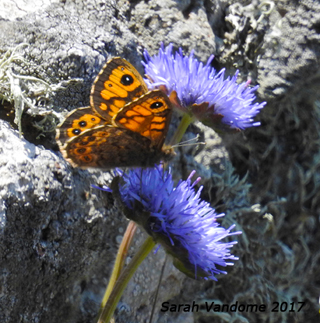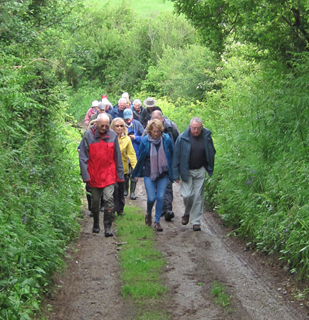 Nare Head epitomises the wildest of our wild landscapes. Its rugged and unforgiving geology defies all attack from the worst of the weather above, and the crashing ocean waves below. So it may come as a surprise that delicate butterflies and moths can thrive here.
Nare Head epitomises the wildest of our wild landscapes. Its rugged and unforgiving geology defies all attack from the worst of the weather above, and the crashing ocean waves below. So it may come as a surprise that delicate butterflies and moths can thrive here.
Nare Head is one of my favourite wild Roseland places, inspired by the dogged determination of living things to survive in this challenging habitat. No tall trees here. Any shrub other than gorse grows sideways, battered by extremes of weather, or becomes bonsai’d by the thin, nutrient-poor soil. Some plant species grow just a few centimetres in height in exposed areas; the gorse provides sheltered pockets for some of the taller ones. There is, nevertheless, enough nectar and pollen on tap to sustain many insects including butterflies and moths. As the spring and summer seasons advance, these animals appear in quite large numbers, even on the very tip of the rocky headland.
 Butterfly Conservation has been recording butterfly species in the Roseland for a number of years. There is a special butterfly transect at Nare: a set route along which observers walk and record all the butterfly species they see. Observations are carried out throughout late spring and summer, so different species can be recorded as they emerge over time. I decided to get involved with recording, as it is a great way to learn how to recognise some of our more uncommon species and see them out in the field. It is only ever a fair weather activity, so all the more enjoyable.
Butterfly Conservation has been recording butterfly species in the Roseland for a number of years. There is a special butterfly transect at Nare: a set route along which observers walk and record all the butterfly species they see. Observations are carried out throughout late spring and summer, so different species can be recorded as they emerge over time. I decided to get involved with recording, as it is a great way to learn how to recognise some of our more uncommon species and see them out in the field. It is only ever a fair weather activity, so all the more enjoyable.
The Nare transect follows the footpath from the National Trust car park, down through the wooded valley to Paradoe Bay, up to the tip of the headland itself, across towards the nuclear bunker, then back around and down towards Kiberick Bay before returning to the car park. Among the more common species you are likely to record are the Meadow brown, Wall, Ringlet, Common blue, Peacock and Painted lady. But if you are lucky, you may see some less common species. On my first transect walk I recorded my first Green hairstreak (Callophrys rubi) (above), the UK’s only green coloured butterfly. The Small pearl-bordered fritillary has also been recorded at Nare in previous years.
 Though I was not recording moths, I did see a species new to me: the Speckled yellow (Pseudopanthera macularia). It is a day-flying moth, and worthy of mention here because of its striking appearance: bright yellow wings with black blotches.
Though I was not recording moths, I did see a species new to me: the Speckled yellow (Pseudopanthera macularia). It is a day-flying moth, and worthy of mention here because of its striking appearance: bright yellow wings with black blotches.
Recording butterlfies is an enjoyable and worthwhile activity that I would thoroughly recommend; in the Roseland it is currently organized by Chris Townsend, who does this work in partnership with the National Trust team at Porth.
Event news: Roseland farm wildlife walk with Mike Harrison
 The visit to Churchtown Farm Veryan, organised through Wild Roseland, was a really well attended, enjoyable and informative experience. Mike Harrison has been combining farming for a living and for wildlife for many years, in an area of great nature and landscape value between Veryan and Carne Beach. He explained what it’s like to farm under the different tiers of government-funded farmland Stewardship schemes. Churchtown Farm, currently in Higher Level Stewardship, is a mixed farm of arable and beef cattle, managed to encourage the presence of Cirl buntings.
The visit to Churchtown Farm Veryan, organised through Wild Roseland, was a really well attended, enjoyable and informative experience. Mike Harrison has been combining farming for a living and for wildlife for many years, in an area of great nature and landscape value between Veryan and Carne Beach. He explained what it’s like to farm under the different tiers of government-funded farmland Stewardship schemes. Churchtown Farm, currently in Higher Level Stewardship, is a mixed farm of arable and beef cattle, managed to encourage the presence of Cirl buntings.
Though none are thought to have settled there yet, the Roseland Cirl population is gradually expanding northwards and should arrive there before long. The habitat is very good and the Cirl bunting’s close relative the Yellowhammer is already present in good numbers; we could hear them singing all around us. Our wildlife relies on Farmers like Mike, who love nature and want to do what they can for wildlife whilst making their livelihood on the land.
Edited by Sarah E Vandome
References and links
Butterfly Conservation:
http://butterfly-conservation.org
Speckled Yellow moth:
http://butterfly-conservation.org/51-1579/speckled-yellow.html
Wild Roseland is on Facebook.
Enjoy more Roseland wildlife and landscapes – visit Sarah Vandome’s Heart of Roseland Facebook feature:
https://www.facebook.com/HeartOfRoseland?ref=hl
Wild Roseland is a group of volunteers who care passionately about looking after the nature and landscape of the Roseland peninsula in south Cornwall. Through a number of initiatives and projects, the aim is to inspire and enhance the conservation of this special place for all.

